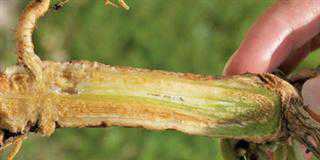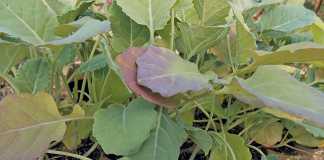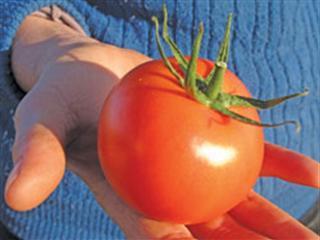
Photo: Keri Harvey
“You have to be a businesswoman and a farmer to make money,” says Hopefield tunnel tomato farmer Amanda Viljoen. “I have chosen to farm intensively on a small scale and produce high quality tomatoes to achieve this.”Amanda studied agriculture at Elsenburg Agricultural College near Stellenbosch and took over tunnel tomato farming from her father 12 years ago. Recent demand for tomatoes year-round has changed the tomato growing sector.
READ: Growing tomatoes in a bacterial wilt area
Today, on the 62ha family farm Skoonsustersbos, she produces tomatoes in eight 30m tunnels, each housing about 600 tomato plants. In summer, she grows an additional 8 000 plants under shade netting.
Growing tomatoes year-round
Tomatoes are normally a summer crop, thriving in warm and dry conditions. However, market demand for tomatoes year-round has led to the development of winter-fruiting cultivars. “We produce long-life tomatoes year. They are in high demand and don’t have to be bought green to ripen. Our tomatoes are vine-ripened and taste so much better.
.jpg)
Tomato sorting done here by Aleta Cleophas requires a trained eye. No fruits with blemishes escape the sorters, and these are removed from the belt.
“We are also close to our market so the tomatoes reach the customers quickly. If the market was further away, we would have to pick fresh to last longer – up to two weeks after being picked. “When we pick, we leave a short length of vine stem attached to the tomato to prevent breaking skin that allows in bacteria.”
Production process
For a crop to be harvested in summer, seeds are sown in a seedling mix in seedling plug trays six weeks before planting time. To germinate, they are kept under a ‘hot blanket’ of reflective insulation.
Seedlings are planted out when the root, above-ground stem and leaves are roughly equally long, which is when the seedling is about 10cm high. “When I tug at the stem just above soil level in the seedling tray and the plug comes out cleanly and easily, it’s ready to transplant,” explains Amanda.
“We transplant the seedlings into black bags filled with pine shavings, and plant our summer crop in mid-July to be ready for harvesting from mid- to end-October through to mid-January.”
The winter crop is planted in January and harvesting generally starts around Easter and lasts until late June. Tunnels are then thoroughly cleaned out, the new growing medium is prepared – or previously used medium is sterilised – and the summer crop is planted in mid-July.
“Tomato farming is very labour intensive,” she admits. “There has to be constant pruning, trellising and checking [to ensure tomatoes year-round]. We have to be around all the time.”
Tunnel farming tomatoes is also highly scientific. “A solar meter measures the UV radiation on the plants, and we water and feed the plants accordingly. “In summer, when it’s warm, the plants are automatically fed more often using a timer – up to 10 times a day. However, in winter when there is little or no sun, the timer triggers fertiliser and watering three times a day.
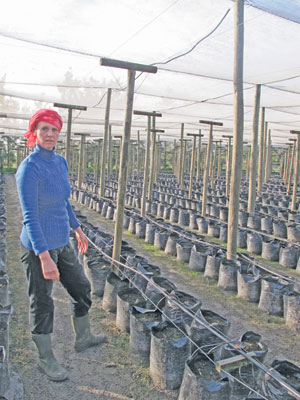
In summer, Amanda also grows tomatoes in tunnels and under a huge shade cloth enclosure.
“The growing medium must stay moist because the plant must take up water all the time, but water must also drain away or it will leave a toxic build-up in the growing medium.” Fertiliser dissolved in water is fed to plants through the irrigation system. The amount must be precisely calculated for the specific crop, climate and water quality. All tomato plants receive the same amount of water and nutrients for optimal growth and fruit quality.
Pest control
Amanda uses a preventative pest control programme, widely practised among tomato farmers. “For us, summer – and especially January – is worm season. This year we had African bollworm (Helicoverpa armigera), which eats the fruit or leaves depending on the stage of plant growth. The caterpillars even kill small plants.
“We also battle with white fly throughout the year, but particularly in summer. White fly breeds rapidly, and is adaptable and resilient. We know we can’t eradicate white fly, but do our best to manage it.”
With her primary harvest season being shorter, tunnels can be cleaned out faster to create a break before the next crop. “We can’t spray daily, and when harvesting we are very limited as to pest control options because we can’t spray too often either,” she adds. In the Sandveld, the main problem in winter is fungus. Botrytis strikes in cool, damp weather where air circulation is poor, so tunnels are ideal for this fungus.
Amanda explains that on the whole she is fortunate that the farm is far from other tomato farms, reducing the contamination problem. “We don’t have a problem with blight or viruses, often serious issues for tomato farmers. It may be because the farm is so isolated.”
Pros and cons of the Sandveld
“To produce tasty tunnel tomatoes, we need good quality water and a lot of it,” Amanda stresses, “Fortunately we have both.” However, tunnels are expensive to set up, compared to open-field farming. Good hygiene practices are essential and constant attention is needed to monitor plants. This makes tunnel farming very intensive.”
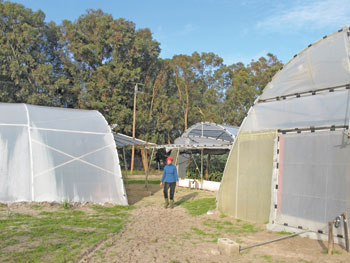
Since the farm is relatively small, intensive farming in tunnels is the solution to produce high yields.
Sandveld soil is very poor and the climate is extremely harsh, so tunnels are essential infrastructure in this area. While tomatoes are planted and fed in pine shavings, the tunnels enable temperature control and provide shade. “If we plant outside, it gets so hot that the tomatoes burn,” she explains. “We have a variety of small game on the farm and they can’t get to the tomatoes in the tunnels, so we can farm in harmony with them.”
The main negative aspect of tunnel farming is that pests breed prolifically in the protection of the tunnels, a closed, warm, humid environment with reduced airflow. Major advantages include perfect fruit and less space requirements for a high yield.
Employing women
Amanda permanently employs three women, Chesna Borrie, Aleta Cleophas and Carolene Witbooi, and one man, Andries Lewis, with additional women employed on a casual basis. “It just happened that way,” she recalls, “but it works well because the plants are delicate and women work gently. They take pride in their work and don’t get bored. The ladies have worked with me for eight, 10 and 12 years respectively and we work very well together.”
Andries does the maintenance of the tunnels and helps load tomatoes during the harvest season. “My main challenge as a woman farmer is physical,” admits Amanda. “I am just not as strong as a man. I also have to be tough to farm here; it’s definitely not for everybody and the heat in summer is unbearable. Finding people to work with me is becoming increasingly difficult, because the younger generation doesn’t want to work on farms.”
Market forces
“Everybody, rich and poor, eats tomatoes. So there will always be a market for them,” says Amanda. “We are too far from the Cape Town market to make it viable, so it made sense to plant a crop that can be sold in the surrounding area. Tomatoes were a good choice, and it’s such a versatile fruit. Tomatoes are the staple fruit.”
Viljoen Boerdery’s tomatoes are delivered directly to shops in the surrounding towns to ensure that tomatoes are available year-round. Amanda’s sister Nicola is in charge of deliveries and maintaining relationships with diverse outlets from Spar to small village shops and weekend markets.
Diversifying into processing
“In summer we have a lot of tomatoes and don’t always have a market, so we are now processing sun-dried tomatoes that we bottle and sell. They are very popular and it gives me great satisfaction to see people enjoying the tomatoes,” muses Amanda.
“If we go bigger, we will need to employ more people and get a manager, whereas now we are small and personal. So I am instead diversifying into less labour intensive lines such as figs and olives. In the meantime, sun-dried tomatoes provide an income between harvests. We compost old tomato plants and cuttings for the fig and olive trees that will soon bear fruit.”
Contact Amanda Viljoen of Viljoen Boerdery on 022 723 1238.
This article was originally published in the 03 August 2012 issue of Farmers Weekly.












